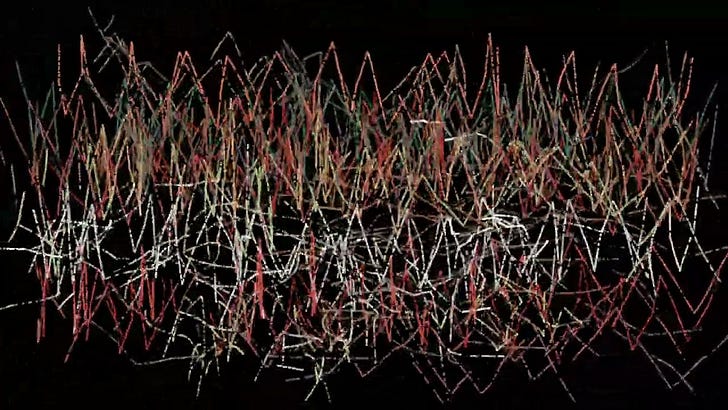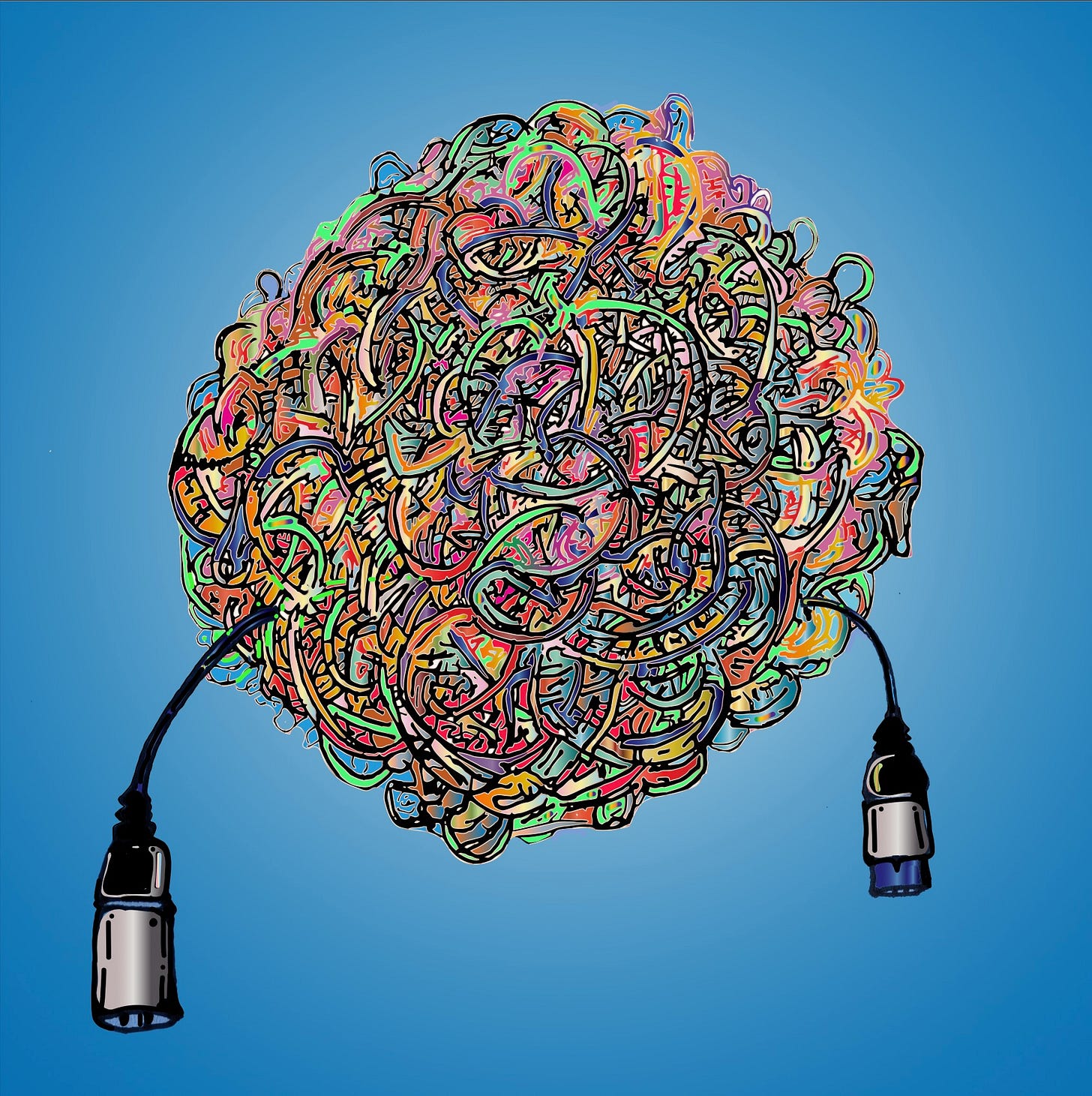“stands like a statue / becomes part of the machine…”
Pinball
Composer / guitarist Bryan Jacobs and I started playing music together in 2022. From the jump, our duo has felt like a perfect fit: we share an enthusiasm for dense, knotty music, and structured-but-unpredictable rhythms. And we think in similar ways about the instruments we use to improvise, and the performer’s relationship to technology.
First, we both use home-brewed software to enhance our abilities as performers. For instance, Bryan’s electronics can transform a simple guitar lick into an impossibly fast cascade of notes, while my software facilitates closely-tuned microtonal scales that don’t map onto a traditional keyboard layout. Second, we’re both interested in software with a degree of autonomy. The electronics make musical decisions (based on the algorithms we’ve designed), and we as performers both adapt to and shape the materials that our instruments generate. We intertwine the real-time decision-making of improvisation with the slow and considered choices of composition - expressing the latter in the code we write and run.
And then we complicate things further by getting into a room together and playing our instruments side-by-side. At which point there’s way more than enough stimulus to react to and bounce off of. Lightning quick, and yet inexorably pulled by gravity, our favorite metaphor for this work is Pinball. Plug a quarter into the machine and hear the results:
If you prefer your overstimulation to be multi-sensory, I’ve put together an animated music video for track 4, “cascade.” It was heaps of fun scheming up a visual that might match the glorious level of bonkers in the music:
I’m not sure how much farther I can push the make-an-animation-with-zero-jumpcuts idea (see also the videos I made for Kyle Bruckmann’s SAWTEETH and acrimonium), but I expect I’ll keep trying.
LV2MKRT
The LV2MKRT podcast wraps up next week with episode 200, nearly four years after bassist Scott Worthington and I launched in March 2021. If you aren’t a regular listener and would like a little curation, some recent favorites (with typically ridiculous titles) include “Unsuccessful exorcism,” “Just like falling off a bicycle,” and “If you don’t maintain a certain degree of fickleness, are you even a cat.” I can’t adequately describe the incredible joy of making this music together with Scott over the course of roughly 80 Quacktrip sessions and at least double that number of hours. (The majority of which, to be sure, we spent gabbing about - in alphabetical order - academia, audio engineering, baseball, bass technique, Boulez, cat parenting, code, donuts, electric cars, footie, the freelance life, and… ok, you get the idea).
Thanks, Scott. You rock.
At the workbench
There are a couple of different projects in the works, but to focus on the newest-in-new: over the last three weeks I’ve begun learning the creative coding environment OPENRNDR, which should provide some interesting new affordances for my visual art and animation work. In terms of its general capabilities, OPENRNDR is relatively similar to Processing, which I’ve used for fifteen-plus years now. (Time flies when you’re making art). However, the underlying programming language is different (Kotlin vs. Java), and the divergences pile up from there. (If I may lapse into full nerdspeak: different IDE, different build tools, different APIs with different paradigms, and <cough> different quality of documentation).
The change is simultaneously stimulating (stretching my brain by learning something new! old dogs learning new tricks! new conveniences and new possibilities!) and maddening (I ALREADY KNOW HOW TO DO THIS WHY DOESN’T IT WORK THIS THING IS STUPID I QUIT GRAHHHH). With a lot of the maddening part.
And so I find myself needing to think explicitly about emotional regulation as it applies to coding, to learning, and to creative work more generally. It’s easy to anticipate that there will be (many, many) frustrations - to enumerate the most trivial:
I can’t even find the right browser tab because I have so many pages of documentation, tutorials, and forums open
there isn’t an example (or there isn’t an explanation, or both)
I don’t understand the example (or the explanation, or both)
my code doesn’t work…
…and fails with an obtuse error message
it works but doesn’t result in what I expected
it works but I didn’t draw anything interesting
I also know (or at least I hope) that there will be matching victories:
OK, I think I get how that’s supposed to work now
I remember what the fix was the last time I saw that error message
my code works…
…and it does what I thought it should
…and it looks good!
or, it’s not what I expected but it IS interesting (as always, I am pro-serendipity)
All of these experiences are part of the process of learning and making - perfectly normal and predictable. Where I get in trouble right now is that because I am doing a familiar type of work (generative animation), I think I should be moving quickly towards the win conditions, and spending most of my time there (though certainly not all). But because I’m using an unfamiliar tool, I’m spending the vast majority of my time in the frustrations and failure modes.
That gulf between expectation and reality means I have to attend to and manage my emotions more explicitly than usual. The more conscious I can be of the oscillation between exasperation and triumph, the more I can anticipate the rhythm of failure and success, the more I can moderate the swings involved. Just as learning requires repetition, managing the feelings around learning takes practice. It’s an old lesson, and one that applies at every level of creative work (I got rejected / I got the gig, this is going to be the best thing I’ve ever made / this is nonsense and I need to start over, etc.), but starting from zero with a new tool means it’s time for me to relearn it. Sometimes, it’s old dogs and old tricks.
Nonce
Cartoonist John Granzow weighs in on the perennial what’s-the-correct-way-to-wrap-and-store-your-cables debate. (At the moment I am also inclined to read it as a 1980s-style public-health campaign: “this is your brain on OPENRNDR”).
Thanks as always for listening, watching, and reading - yours,
Christopher
Christopher Burns
sfsound.org/~cburns



